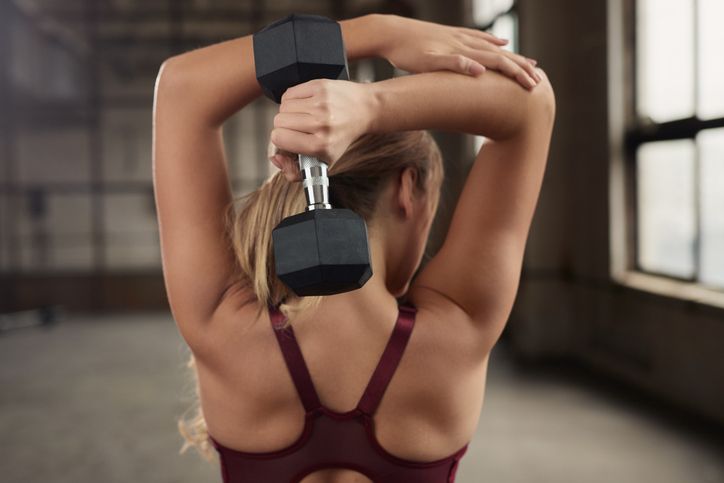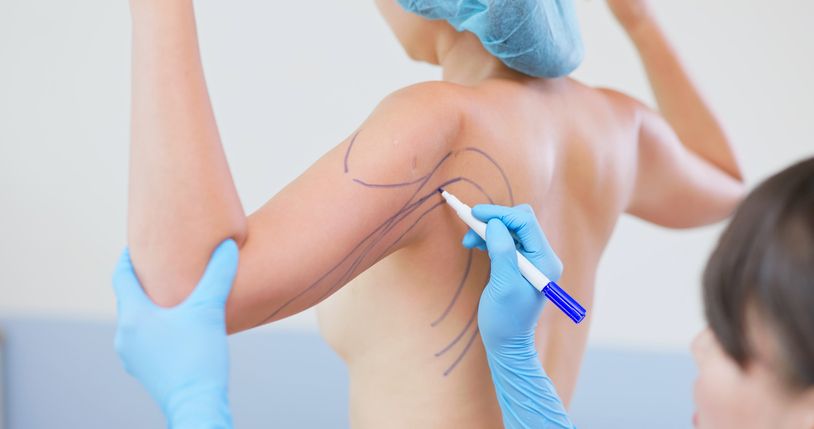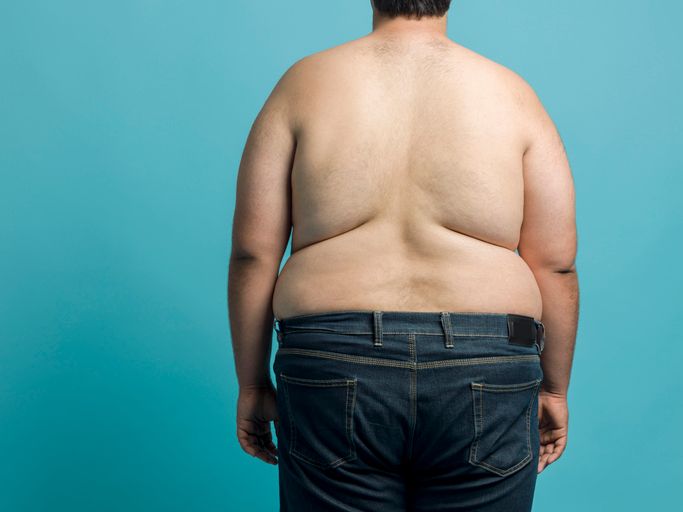
Author: Natalie Ng|Updated: 5 May 2025
Back fat is one of the most frustrating and stubborn areas of the body when it comes to losing fat. It can sneak up on you even if you're active and eating well. Whether it’s upper back fat, lower back fat, or the dreaded “bra bulge,” many people struggle to get rid of back fat despite following a consistent workout program and watching their calorie intake. The truth is, back fat is influenced by various factors, including your body composition, genetics, lifestyle choices, and even cortisol levels. Unfortunately, the internet is flooded with myths about how to target and eliminate back fat. In this article, we’re debunking nine of the most common misconceptions — with real, expert-backed insights on what actually works.

Myth 1: Back Fat Means You’re Overweight

Many assume that visible back fat is a clear sign of being overweight, but in reality, the connection between fat storage and body weight isn’t that straightforward. The body stores fat based on several factors beyond just how much you weigh — including genetics, hormones, body composition, and daily lifestyle choices.
Back Fat Can Appear on Slim or Fit Individuals
Even people with low overall body fat or those who follow a strict workout program can develop back fat. This happens because the body doesn’t lose fat evenly across all areas. For some, the body stores fat in the upper back near the shoulder blades, while others accumulate fat in the lower back. These areas can be resistant to fat loss even when you’re in a calorie deficit and exercising regularly.
Body Composition Matters More Than the Number on the Scale
Your body weight alone doesn’t paint the full picture. Someone may fall within a healthy weight range but still have a high percentage of body fat and low muscle mass — a condition often referred to as being “skinny fat.” Without enough lean muscle, your back can lack definition and appear soft, even if you haven’t gained weight. Improving body composition through strength training and building muscle is often more effective than trying to simply lose weight.
Hormones and Genetics Influence Where the Body Stores Fat
Your genetic makeup plays a major role in where your body tends to store fat. Some individuals are predisposed to carry more fat in the back area, regardless of how much they eat or how frequently they exercise. Hormonal changes and elevated cortisol levels — often caused by stress or lack of sleep — can also lead the body to store fat around the midsection and back.
Focus on Muscle Growth and Smart Fat Loss
To get rid of back fat effectively, it’s important to move beyond just the scale. A combination of strength training exercises like bent over rows, pull ups, and cable machine movements can help build muscle and sculpt the back. Coupled with cardiovascular exercises and a healthy diet that avoids processed foods and empty calories, this approach supports long-term fat loss throughout the entire body.
Working with a certified personal trainer can be extremely beneficial when designing a personalized workout program. They can help you avoid common mistakes, improve your posture and form (like keeping your feet shoulder width apart and hips forward), and align your daily routine with your fitness goals.

Myth 2: You Can Spot Reduce Back Fat with Targeted Exercises

One of the most persistent fitness myths is the idea that you can spot reduce fat in a specific area of your body — such as targeting back fat with focused exercises. While it may sound appealing to isolate a problem area and make it disappear, the science says otherwise. Spot reduction is not an effective approach to fat loss, and understanding why can help set more realistic expectations and better results.
Fat Loss Happens Across the Entire Body
When you're in a calorie deficit, your body begins burning calories from fat stores for energy. However, it doesn’t choose where to burn fat from — it draws energy from fat cells all over the body. That means no matter how many back-focused exercises you do, like one arm dumbbell rows or pull ups, you won't selectively lose fat in that specific area. Your genetics determine the order in which your body burns fat, and often, stubborn back fat is one of the last to go.
Back Exercises Build Strength, Not Fat Loss
Exercises like bent over rows, cable machine pull downs, or back extensions are excellent for strengthening your back muscles. These movements improve posture, support spine health, and can enhance the appearance of the back by building muscle — but they don't directly reduce fat in that area. Building muscle mass in your back can help your body look more sculpted and defined as your overall body fat decreases, but this only works if paired with fat loss strategies that target the entire body.
Combine Cardio, Strength Training, and Nutrition
To get rid of back fat effectively, your workout program needs to include a mix of strength training and cardiovascular exercises. Cardio helps with burning calories and improving heart health, while weight training builds lean muscle that boosts your metabolism. Together, they create a more efficient fat-burning environment in the body. Add in a healthy diet with controlled calorie intake and minimal processed foods, and you’ll be supporting fat loss not only in the back, but throughout the entire body.
Focus on Full-Body Movement and Core Stability
Exercises that engage multiple muscle groups — such as rows, squats, deadlifts, and even core stabilizers — are more effective for burning calories and transforming your body composition. Incorporating full range movements and training on a stable surface with good form (feet shoulder width, hips forward, back straight) enhances the efficiency of your workouts. These compound exercises not only build strength but also burn more calories overall.
Spot reduction may sound like a shortcut, but long-term success comes from focusing on the big picture: regular exercise, building muscle, eating with intention, and maintaining realistic expectations.
Read More
Book Now to Experience
S6 Body Sculpting Treatment
1 Minute Self-Registration
Date should not be before minimal date

Myth 3: Back Fat Is Only a Cosmetic Issue

While many people view back fat as simply an aesthetic concern, the truth is that it can be a reflection of deeper issues related to body composition, lifestyle choices, and even hormonal imbalances. Treating back fat as a surface-level problem can prevent you from addressing the real causes — and from making long-term, sustainable changes that improve not just appearance, but overall health.
Back Fat Can Indicate Imbalances in Body Composition
When your body has a higher percentage of fat compared to muscle, it tends to store fat more easily — and often in places like the back, especially the lower back and near the shoulder blades. This is particularly common for individuals who lead sedentary lifestyles, consume too many empty calories, or avoid strength training. Back fat, in this context, becomes a visible sign of poor body composition, not just a cosmetic flaw.
If your goal is to improve your appearance, focusing on building muscle mass is far more effective than trying to simply lose weight. A consistent workout program that includes strength training and muscle growth, combined with a healthy diet, helps reshape your physique and reduces fat from the entire body, including the back.
Fat Storage Is Connected to Hormonal and Lifestyle Factors
Where your body stores fat isn’t random — it’s often a response to internal factors like elevated cortisol levels (caused by chronic stress), lack of sleep, poor food choices, or hormonal changes. For example, women going through hormonal shifts during menopause may find their bodies store more fat in the back or midsection. In men, a drop in testosterone can reduce muscle mass and increase fat accumulation.
Back fat may therefore signal that it’s time to assess lifestyle habits — not just for the sake of aesthetics but for long-term health. Improving sleep quality, reducing stress, and following a nutrient-dense diet can be extremely beneficial in regulating how the body stores and burns fat.
Physical Discomfort and Postural Issues
In some cases, back fat can contribute to physical discomfort. It may cause bra band rolling in women or tightness in clothing that leads to skin irritation. Additionally, excess fat around the back can impact posture. Without strong back muscles to support the spine, your body may compensate with poor alignment, leading to shoulder and neck strain.
That’s why focusing on building back strength through exercises like rows, pull ups, and cable machine work isn’t just about looks — it also supports spinal stability and mobility. A certified personal trainer can tailor a routine that strengthens your back while addressing imbalances and improving your daily routine.
The Bigger Picture: Confidence and Overall Health
Although back fat is often labeled a cosmetic concern, its impact on self-confidence can be significant. Many people avoid certain clothes or feel uncomfortable in their own bodies because of how back fat makes them look or feel. By taking steps to address this issue through a combination of regular exercise, proper nutrition, and expert advice, you're not only improving how your body looks — you're also boosting your confidence, energy, and overall health.

Myth 4: Only Surgery Can Get Rid of Back Fat

When it comes to stubborn back fat, many people believe that surgery — such as liposuction — is the only way to truly get rid of it. While surgical procedures can offer dramatic results, they are not the only effective method available. With advancements in medical aesthetics, non-surgical body contouring and fat reduction treatments have become more accessible, effective, and safe. The idea that surgery is your only option overlooks how powerful consistent training, smart nutrition, and non-invasive technologies can be in reshaping your body.
Non-Surgical Treatments Can Be Extremely Effective
There are now several non-invasive or minimally invasive procedures that can help reduce back fat without the need for cuts, stitches, or a long recovery process. Treatments such as cryolipolysis (fat freezing), radiofrequency energy, and ultrasound-based devices work by targeting and breaking down fat cells in localized areas. These methods support fat loss by gradually reducing the thickness of stubborn fat pockets, particularly around the upper and lower back.
Although results take longer to appear compared to surgery, these treatments allow clients to return to their daily routine almost immediately. They are especially beneficial for people with healthy body composition who simply want to refine specific areas that haven’t responded to exercise and diet.
Lifestyle and Exercise Still Play a Key Role
Regardless of whether you choose a surgical or non-surgical approach, your daily habits will always influence your long-term results. Back fat often returns if you're not maintaining a consistent workout program, especially one that includes strength training and cardiovascular exercises. Movements like bent over rows, pull ups, and using a cable machine help activate back muscles and support muscle growth, which in turn helps your body burn more calories even at rest.
Incorporating a healthy diet, avoiding processed foods, and managing calorie intake are also critical. If you're consuming more calories than your body uses — even after a treatment — fat can return. Combining aesthetic treatments with lifestyle changes gives you the best chance at sustainable success.
Surgery May Be Necessary for Some — But Not All
In certain cases, surgical fat removal might be the best option, especially for individuals with larger areas of fat or skin laxity. However, this should be viewed as a last resort after more conservative methods have been explored. Surgery comes with higher costs, longer recovery times, and potential complications, making it a bigger commitment physically and financially.
Consulting with a certified personal trainer or a qualified medical aesthetics expert can help you understand which method is best suited to your fitness goals and body type. Many people are surprised to discover that a combination of regular exercise, clean nutrition, and a few targeted treatments is enough to significantly reduce back fat and improve body shape.
Book Now to Experience
S6 Body Sculpting Treatment
1 Minute Self-Registration
Date should not be before minimal date

Myth 5: If You Work Out Enough, It Will Eventually Disappear

It’s a hopeful thought — that with enough sweat and reps, back fat will simply melt away. While regular exercise is essential for improving health, boosting energy, and building muscle, it's not a magic bullet for stubborn back fat. In fact, many people who exercise frequently still struggle to get rid of back fat, and the reason comes down to how the body loses fat and what it needs in order to change body composition.
Stubborn Fat Doesn’t Always Respond to More Exercise
Back fat — particularly in the lower back and around the shoulder blades — tends to be one of the last places where the body burns fat. This is especially true if your cortisol levels are high or your body stores fat genetically in that region. While increased physical activity helps with burning calories, you can’t force your body to burn fat from one specific area just by working out more.
In many cases, increasing your workout frequency without adjusting your calorie intake or focusing on quality recovery can lead to burnout or plateau. More isn’t always better — smarter is.
Overtraining Without Strategy Can Backfire
Spending hours in the gym won’t necessarily lead to better results if you’re not training with purpose. If your workouts lack a mix of strength training and cardiovascular exercises, you might not be building muscle or maximizing fat loss. Compound movements like bent over rows, pull ups, and exercises using a cable machine help develop the back muscles, while high-intensity intervals and steady-state cardio support calorie burn.
However, without proper form (such as maintaining feet shoulder width, keeping hips forward, and using full range of motion), you might not be fully engaging your muscles or burning as many calories as you think. A certified personal trainer can help refine your routine to make every workout more effective.
Recovery and Nutrition Are Equally Important
Exercise is just one part of the equation. If your goal is to change your body composition and reduce back fat, your recovery process and diet must also align. A poor night’s sleep, high stress, or eating too many empty calories can undo the benefits of your workouts.
A healthy diet that supports fat loss includes nutrient-dense foods, lean proteins for muscle growth, and enough calories to fuel your daily routine without putting you in a surplus. When your body is in a consistent calorie deficit — even a small one — fat loss happens across the entire body, including the back.
Set Realistic Expectations and Track Progress Holistically
Expecting back fat to disappear quickly with exercise alone can lead to frustration. Sustainable results take time, especially in stubborn areas. Instead of relying on the mirror or scale alone, track your progress through measurements, how your clothes fit, and improvements in your strength and posture.
Regular exercise is essential, but it works best when paired with smart food choices, lifestyle changes, and realistic expectations. When all elements are working together, that’s when you’ll start to see meaningful change.

Myth 6: Back Fat Only Affects Women

It’s a widespread misconception that back fat is primarily a female concern, often associated with bra bulge or tight clothing. While it's true that women tend to store fat in the upper and lower back due to hormonal factors, men are just as likely to struggle with back fat — particularly around the lower back and sides, often referred to as “love handles.” Back fat is not gender-specific; it’s a result of how the body stores fat and responds to various lifestyle factors.
Men Store Fat Differently — But Not Exempt from Back Fat
In general, men tend to store fat in the abdominal area and lower back due to their hormonal profile. As testosterone levels decline with age or inactivity, muscle mass decreases, and fat accumulation becomes more likely. This includes the lower back, where stubborn fat often lingers, even when other parts of the body start to lean out.
For women, estrogen tends to direct fat storage to the upper back, arms, and hips. However, both genders can experience stubborn back fat — especially when calorie intake exceeds what the body needs, and muscle mass is low.
The Importance of Muscle Mass for Both Men and Women
A major contributor to visible back fat in both men and women is low muscle mass. Without sufficient strength training, the back can lose tone and definition, making fat in that area more noticeable. Exercises like pull ups, bent over rows, and cable machine work are extremely beneficial for activating back muscles and supporting overall muscle growth. These should be staples in any well-rounded workout program, regardless of gender.
Building muscle not only enhances physical appearance, but also helps your body burn more calories at rest. A stronger back contributes to better posture, reduces the appearance of back fat, and supports better overall health.
Lifestyle and Hormones Play a Role for Everyone
Whether you're male or female, your hormone balance, stress levels, sleep patterns, and food choices all affect how your body stores fat. High cortisol levels, lack of recovery, and poor eating habits can lead to increased fat storage in areas like the back. Men and women alike benefit from maintaining a consistent exercise routine, prioritizing recovery, and sticking to a healthy diet to support fat loss.
A certified personal trainer can tailor workouts for any gender, focusing on the areas where each individual stores fat most stubbornly. The goal isn’t to spot reduce, but to improve body composition and reach your fitness goal in a sustainable, realistic way.
Back fat is not a women-only issue — it affects everyone. The good news is that the same principles of fat loss, muscle building, and healthy living apply across the board.
Book Now to Experience
S6 Body Sculpting Treatment
1 Minute Self-Registration
Date should not be before minimal date

Myth 7: All Back Fat Is the Same

It’s easy to think of back fat as one general problem — but in reality, not all back fat is the same. Understanding the differences between where fat appears on the back and how it behaves is essential for choosing the right approach to fat loss and muscle development. Treating back fat as a single, uniform issue often leads to ineffective strategies that don’t address specific problem areas.
Different Areas Store Fat Differently
The back is made up of several regions, and each one can store fat in distinct ways. Upper back fat typically gathers near the shoulder blades, around the bra line in women, or just under the armpits. This area may be more fibrous, meaning it feels firm and dense, and is often resistant to traditional fat loss methods.
Lower back fat, on the other hand, tends to collect near the waistline and around the flanks or love handles. This fat is usually softer and may respond better to lifestyle changes like calorie deficit, cardiovascular exercises, and regular strength training.
Because the body stores fat differently across these regions, targeting back fat requires a personalized approach. Exercises, diet, and treatments that work for one area may not be as effective for another.
Isolated Exercises Won’t Address Every Type of Back Fat
Trying to target all back fat with one or two exercises — like bent over rows or cable machine pull-downs — won’t lead to balanced results. While these are excellent for building the back muscles, they don’t work every region equally. For example, exercises like pull ups are great for developing upper back strength, while deadlifts and one arm rows may better activate lower back muscles.
Working with a certified personal trainer can help ensure your workout program includes a full range of movements that target the entire back, from top to bottom. A strong back doesn’t just look better — it supports better posture, core stability, and overall health.
Aesthetic Treatments May Vary by Area
If you choose to explore non-surgical aesthetic treatments to get rid of back fat, understanding the difference between upper and lower back fat becomes even more important. Some fat reduction treatments are better suited for dense, fibrous areas like the upper back, while others are ideal for softer, pinchable fat in the lower back. This is why expert advice is essential when selecting a fat loss treatment — results improve significantly when the method matches the type of fat being treated.
Combining targeted exercise, healthy eating habits, and treatments tailored to your body can make a noticeable difference in how your back looks and feels. Ultimately, recognizing that back fat isn’t a one-size-fits-all issue allows for smarter, more sustainable results.

Say Goodbye to Stubborn Back Fat with S6 Body Sculpting Treatment
By now, you know that stubborn back fat doesn’t disappear overnight — and certainly not without effort. But even with the right diet, consistent workout program, and realistic expectations, many people still struggle to lose fat from the back. Why? Because the body stores fat unevenly, and the back — especially the upper back near the shoulder blades and the lower back above the hips — is often the last place where fat starts to melt away.
This is where professional support can make all the difference.
What Is S6 Body Sculpting Treatment?
The S6 Body Sculpting Treatment is a non-invasive, non-surgical fat reduction therapy that targets fat in hard-to-tone areas — including the back — using low-energy bio-laser technology. This laser safely penetrates deep into the subcutaneous fat layer, breaking down fat cells by releasing fatty acids. These are then naturally expelled through the lymphatic drainage process, enhanced by gentle vacuum suction massage that boosts your metabolic rate.
What sets S6 apart is its ability to target localized fat, something that’s nearly impossible to achieve through exercise and diet alone. If you've been doing everything to lose weight, improve your body composition, and still find fat clinging to your back — this treatment can provide the extra boost your body needs.
How the S6 Treatment Enhances Your Fat Loss Journey
Rather than replacing regular exercise or a healthy diet, the S6 Body Sculpting Treatment works alongside them to accelerate results. When combined with weight training, strength training, and proper nutrition, this treatment helps reshape your back and enhance muscle visibility by reducing the stubborn layer of fat covering your back muscles.
It also tackles common challenges associated with rapid fat loss. Many people worry about loose or sagging skin as they lose body fat. The S6 treatment stimulates collagen production, which helps firm and tighten the skin — so you're not just losing fat, you’re also improving skin texture and elasticity.
Key Benefits of S6 Body Sculpting
• Targets seven major stubborn fat areas, including the back, belly, arms, waist, and thighs
• Non-invasive: no downtime, no needles, no surgery
• Accelerates fat metabolism and helps flush out released fatty acids
• Supports muscle definition by reducing the layer of fat hiding your hard-earned muscle tone
• Improves skin firmness while reducing fat
• Safe and comfortable for a wide range of body types and fitness levels
For anyone looking to get rid of back fat, especially in areas resistant to traditional training, S6 offers a powerful, professional-level solution. Whether you're struggling with upper back fat, lower back fat, or just want to enhance the effects of your workout program, this treatment fits seamlessly into your routine without interrupting your daily life.
Ready to Take the Next Step?
Don’t let stubborn back fat hold you back from your goals. Book your consultation today and discover how the S6 Body Sculpting Treatment can help you sculpt a stronger, leaner, and more confident version of yourself — no surgery, no recovery time, just real, visible results.
New Beauty's S6 Body Sculpting TreatmentBook Now to Experience
S6 Body Sculpting Treatment
1 Minute Self-Registration
Date should not be before minimal date
FAQ
1. Why do I gain back fat even when my weight stays the same?
Your body stores fat based on a combination of genetics, hormones, and daily habits. Even if your weight doesn’t change, shifts in body composition — such as losing muscle mass or consuming more empty calories — can lead to increased fat storage in areas like the back. High cortisol levels from stress can also play a role in how and where the body chooses to store fat.
2. Can back fat be a sign of poor posture or weak muscles?
Yes. Weak back muscles and a sedentary lifestyle can contribute to the appearance of back fat. Poor posture — especially slouched shoulders or an inactive core — makes fat accumulation more visible. Incorporating strength training exercises and working on posture can support better muscle growth and reduce the visual impact of back fat.
3. How can I tell if my back fat is due to diet or lack of exercise?
Both factors often play a role. A high calorie intake without sufficient calorie burn through regular exercise can lead to fat accumulation, including on the back. Analyzing your food choices, activity level, and whether you’re burning calories consistently through cardiovascular exercises or weight training can help you pinpoint the cause.
4. Are certain body types more prone to back fat?
Yes. Your body stores fat in patterns largely influenced by your genetic body type. Some people naturally carry more fat in the upper body, while others may store it around the lower back or hips. Understanding your body composition and working with a certified personal trainer can help tailor your workout program to your specific needs.
5. Will increasing my protein intake help reduce back fat?
Increasing protein can be helpful, especially if you're trying to build muscle and improve your metabolism. A protein-rich diet supports muscle growth, helps preserve lean muscle during fat loss, and can curb cravings that often lead to overconsumption of calories. Combined with the right fitness goal, it can support efforts to get rid of back fat more efficiently.
Recommended Articles
COPYRIGHT© NEW BEAUTY MANAGEMENT LIMITED 2025. ALL RIGHT RESERVED.




